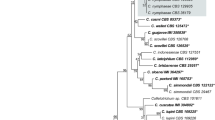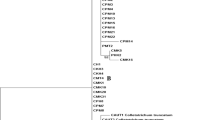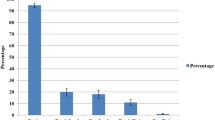Abstract
Colletotrichum alienum, C. asianum, C. fructicola, C. karstii and C. siamense were identified from 87 isolates previously assigned to C. gloeosporioides sensu lato from fruit of avocado (Persea americana cv. Hass) and mango (Mangifera indica cv. Kensington Pride) with post-harvest anthracnose and pre-harvest pepper spot diseases. Colletotrichum alienum, C. fructicola and C. karstii were only found amongst isolates from avocado. Colletotrichum asianum was only seen in isolates from mango, most frequently associated with both post-harvest anthracnose and pre-harvest pepper spot. Colletotrichum siamense was found amongst isolates from both hosts, although it was more commonly encountered in association with disease symptoms in avocado than in mango. This study did not identify any pathogenic or molecular features between isolates causing post-harvest anthracnose and those causing pre-harvest pepper spot symptoms.
Similar content being viewed by others
References
Abang MM, Winter S, Green KR, Hoffmann P, Mignouna HD, Wolf GA (2002) Molecular identification of Colletotrichum gloeosporioides causing yam anthracnose in Nigeria. Plant Pathol 51:63–71
Alahakoon PW, Brown AE, Sreenivasaprasad S (1994) Cross-infection potential of genetic groups of Colletotrichum gloeosporioides on tropical fruit. Physiol Mol Plant Pathol 44:93–103
Cai L, Hyde KD, Taylor PWJ, Weir BS, Waller JM, Abang MM, Zhang JZ, Yang YL, Phoulivong S, Liu ZY, Prihastuti H, Shivas RG, McKenzie EHC, Johnston PR (2009) A polyphasic approach for studying Colletotrichum. Fungal Divers 39:183–204
Damm U, Cannon PF, Woudenberg JHC, Johnston PR, Weir BS, Tan YP, Shivas RG, Crous PW (2012) The Colletotrichum boninense species complex. Stud Mycol 15:1–36
De Hoog GS, Gerrits van den Ende AHG (1998) Molecular diagnostics of clinical strains of filamentous basidiomycetes. Mycoses 41:183–189
De Silva DD, Ades PK, Crous PW, Taylor PWJ (2017) Colletotrichum species associated with chili anthracnose in Australia. Plant Pathol 66:254–267
Dodd JC, Prusky D, Jeffries P (1997) Fruit diseases. In: Litz RE (ed) The Mango: Botany, Production and Uses. CAB International, Wallingford, pp 257–280
Freeman S, Katan T, Shabi E (1998) Characterisation of Colletotrichum species responsible for anthracnose diseases of various fruit. Plant Dis 82:596–605
Giblin FR (2006) Avocado fruit responses to Colletotrichum gloeosporioides. PhD Thesis, CRC for Tropical Plant Protection, University of Queensland, Brisbane
Giblin FR, Coates LM, Irwin JAG (2010) Pathogenic diversity of avocado and mango isolates of Colletotrichum gloeosporioides causing anthracnose and pepper spot in Australia. Australas Plant Pathol 39:50–62
Glass NL, Donaldson G (1995) Development of primer sets designed for use with PCR to amplify conserved genes from filamentous ascomycetes. Appl Environ Microbiol 61:1323–1330
Hayden HL, Pegg KP, Aitken EAB, Irwin JAG (1994) Genetic relationships as assessed by molecular markers and cross-infection among strains of Colletotrichum gloeosporioides. Aust J Bot 42:9–18
Hodson A, Mills PR, Brown AE (1993) Ribosomal and mitochondrial DNA polymorphisms in Colletotrichum gloeosporioides isolated from tropical fruit. Mycol Res 97:329–335
Huang F, Chen GQ, Hou X, Fu YS, Cai L, Hyde KD, Li HY (2013) Colletotrichum species associated with cultivated citrus in China. Fungal Divers 61:61–74
Hyde KD, Cai L, Cannon PF, Crouch JA, Crous PW, Damm U, Goodwin PH, Chen H, Johnston PR, Jones EBG, Liu ZY, McKenzie EHC, Moriwaki J, Noireung P, Pennycook SR, Pfenning LH, Prihastuti H, Sato T, Shivas RG, Tan YP, Taylor PWJ, Weir BS, Yang YL, Zhang JZ (2009a) Colletotrichum – names in current use. Fungal Divers 39:147–182
Hyde KD, Cai L, McKenzie EHC, Yang YL, Zhang J, Prihastuti H (2009b) Colletotrichum: a catalogue of confusion. Fungal Divers 39:1–17
James RS, Ray J, Tan YP, Shivas RG (2014) Colletotrichum siamense, C. theobromicola and C. queenslandicum from several plant species and the identification of C. asianum in the Northern Territory, Australia. Australasian Plant Disease Notes 9: 138
Jayawardena RS, Hyde KD, Damm U, Cai L, Liu M, Li XH, Zhang W, Zhao WS, Yan JY (2016) Notes on currently accepted species of Colletotrichum. Mycosphere 7(8):1192–1260
Johnston PR, Jones D (1997) Relationships among Colletotrichum isolates from fruit-rots assessed using rDNA sequences. Mycologia 89:420–430
Johnston PR, Pennycook SR, Manning MA (2005) Taxonomy of fruit-rotting fungal pathogens: what's really out there? New Zealand Plant Protection 58:42–46
Lima NB, de Batista MV, A, De Morais MA Jr, Barbosa MAG, Michereff SJ, Hyde KD, Câmara MPS (2013a) Five Colletotrichum species are responsible for mango anthracnose in northeastern Brazil. Fungal Divers 61:75–88
Lima NB, Marques MW, Michereff SJ, Morais MA Jr, Barbosa MAG, Câmara MPS (2013b) First report of mango anthracnose caused by Colletotrichum karstii in Brazil. Plant Dis 97(9):1248
Liu F, Damm U, Cai L, Crous P (2013) Species of the Colletotrichum gloeosporioides complex associated with anthracnose diseases of Proteaceae. Fungal Divers 61:89–105
Liu LP, Shu J, Zhang L, Hu R, Chen CQ, Yang LN, Lu BH, Liu YN, Yu L, Wang X, Li Y, Gao J (2017) First report of post-harvest anthracnose on mango (Mangifera indica) caused by Colletotrichum siamense in China. Plant Dis 101(5):833
O’Donnell K, Cigelnik E (1997) Two divergent intragenomic rDNA ITS2 types within a monophyletic lineage of the fungus Fusarium are nonorthologous. Mol Phylogenet Evol 7:103–116
Phoulivong S, Cai L, Chen H, McKenzie EHC, Abdelsalam K, Chukeatirote E, Hyde KD (2010) Colletotrichum gloeosporioides is not a common pathogen on tropical fruit. Fungal Divers 44:33–43
Prihastuti S, Cai L, Chen H, McKenzie EHC, Hyde KD (2009) Characterization of Colletotrichum species associated with coffee berries in northern Thailand. Fungal Divers 39:89–109
Qin LP, Huang SL, Lin SH, Lin CH (2017) First report of anthracnose of Mangifera indica caused by Colletotrichum siamense in Sanya City in China. Plant Dis 101:1038
Rojas EI, Rehner SA, Samuels GJ, Van Bael SA, Herre EA, Cannon P, Chen R, Pang J, Wang R, Zhang Y, Peng YQ, Sha T (2010) Colletotrichum gloeosporioides s.l. associated with Theobroma cacao and other plants in Panama: multilocus phylogenies distinguish host-associated pathogens from asymptomatic endophytes. Mycologia 102(6):1318–1338
Sharma G, Kumar N, Weir BS, Hyde KD, Shenoy BD (2013) The ApMat marker can resolve Colletotrichum species: a case study with Mangifera indica. Fungal Divers 61:117–138
Sharma G, Gryzenhout M, Hyde KD, Pinnaka AK, Shenoy BD (2015a) First report of Colletotrichum asianum causing mango anthracnose in South Africa. Plant Dis 99:725
Sharma G, Pinnaka AK, Shenoy BD (2015b) Resolving the Colletotrichum siamense species complex using ApMat marker. Fungal Divers 71:247–264
Sharma G, Maymon M, Freeman S (2017) Epidemiology, pathology and identification of Colletotrichum including a novel species associated with avocado (Persea americana) anthracnose in Israel. Sci Rep 7:15839
Shivas RG, Tan YP (2009) A taxonomic re-assessment of Colletotrichum acutatum, introducing C. fioriniae comb. et stat. nov. and C. simmondsii sp. nov. Fungal Divers 39:111–122
Shivas RG, Tan YP, Edwards J, Dinh Q, Maxwell A, Andjic V, Liberato JR, Anderson C, Beasley DR, Bransgrove K, Coates LM, Cowan K, Daniel R, Dean JR, Lomavatu MF, Mercado-Escueta D, Mitchell RW, Thangavel R, Tran-Nguyen LTT, Weir BS (2016) Colletotrichum species in Australia. Australas Plant Pathol 45(5):447–464
Silva-Rojas HV, Ávila-Quezada GD (2011) Phylogenetic and morphological identification of Colletotrichum boninense: a novel causal agent of anthracnose in avocado. Plant Pathol 60:899–908
Simmonds JH (1965) A study of the species of Colletotrichum causing ripe fruit rots in Queensland. Queensland J Agric Anim Sci 22:437–459
Stephenson SA, Green JR, Manners JM, Maclean DJ (1997) Cloning and characterisation of glutamine synthetase from Colletotrichum gloeosporioides and demonstration of elevated expression during pathogenesis on Stylosanthes guianensis. Curr Genet 31(5):447–454
Sutton BC (1980) The Coelomycetes: fungi imperfecti with pycnidia, acervuli and stromata. Commonwealth Mycological Institute, Kew
Sutton BC (1992) The genus Glomerella and its anamorph Colletotrichum. In: Bailey JA, Jeger MJ (eds) Colletotrichum: Biology, Pathology and Control. CABI, Wallingford, pp 1–26
Templeton MD, Rikkerink EHA, Solon SL, Crowhurst RN (1992) Cloning and molecular characterisation of the glyceraldehyde-3-phosphate dehydrogenase-encoding gene and cDNA from the plant pathogenic fungus Glomerella cingulata. Gene 122:225–230
Uduyanga D, Manamgoda DS, Liu X, Chukeatirote E, Hyde KD (2013) What are the common anthracnose pathogens of tropical fruit? Fungal Divers 61:165–179
Weir B, Johnston PR, Damm U (2012) The Colletotrichum gloeosporioides species complex. Stud Mycol 73:115–180
White TJ, Bruns T, Lee S, Taylor J (1990) Amplification and direct sequencing of fungal ribosomal RNA genes for phylogenetics. In: Innis MA, Gelfand DH, Sninsky JJ, White TJ (eds) PCR Protocols: A guide to Methods and Applications. Academic Press, San Diego, pp 315–322
Willingham SL, Cooke AW, Coates LM, Pegg KP (2000) Pepper spot: A new preharvest Colletotrichum disease of avocado cv. Hass. Australas Plant Pathol 29:151
Acknowledgements
Much of this work was originally funded by Horticulture Australia Ltd. (now Hort Innovation), the Department of Primary Industries Queensland (now Department of Agriculture and Fisheries Queensland), Avocados Australia, and the Cooperative Research Centre for Tropical Plant Protection/University of Queensland. Additional funding was recently provided by the Australian Biological Resources Study. The authors would like to acknowledge the support and funding by these organisations.
Author information
Authors and Affiliations
Corresponding author
Rights and permissions
About this article
Cite this article
Giblin, F.R., Tan, Y.P., Mitchell, R. et al. Colletotrichum species associated with pre-and post-harvest diseases of avocado and mango in eastern Australia. Australasian Plant Pathol. 47, 269–276 (2018). https://doi.org/10.1007/s13313-018-0553-0
Received:
Accepted:
Published:
Issue Date:
DOI: https://doi.org/10.1007/s13313-018-0553-0




